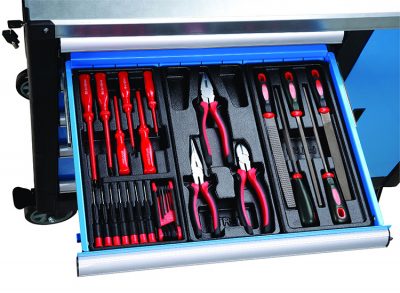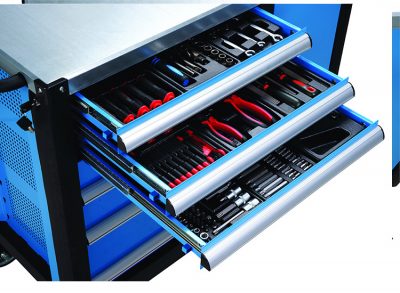Tool trolleys and traditional toolboxes both serve the purpose of storing and organizing your tools, but they have distinct features and benefits. Here’s a comparison between tool trolleys and traditional toolboxes to help you understand their differences:
Tool Trolleys:
- Mobility: Tool trolleys come with wheels or casters, allowing you to easily move your tools around your workspace. This is particularly useful when you need to work on different projects in various areas.
- Organization: Tool trolleys offer multiple drawers, compartments, and shelves, allowing for more detailed and customizable organization of your tools. This makes it easier to find specific tools quickly.
- Accessibility: Tools are readily accessible as you can bring the trolley directly to your workspace. This eliminates the need to constantly walk back and forth to a fixed toolbox.
- Storage Capacity: Tool trolleys generally provide more storage space compared to traditional toolboxes, making them suitable for a wide variety of tools and equipment.
- Customization: Many tool trolleys allow you to adjust drawer layouts, dividers, and compartments to suit your tool collection and workflow.
- Efficiency: Tool trolleys streamline your workflow by keeping your tools organized and within reach. This can lead to increased productivity and reduced downtime.
- Professionalism: Tool trolleys can enhance the professional appearance of your workspace, showcasing your dedication to organization and efficiency.
- Security: Some tool trolleys come with locking mechanisms to secure your tools when not in use or when you’re not around.
- Adaptability: Tool trolleys are versatile in dynamic work environments where you need to move your tools frequently and adjust your workspace layout.
Traditional Toolboxes:
- Portability: Traditional toolboxes are portable and easy to carry to different locations, making them suitable for projects on the go.
- Compactness: Toolboxes are compact and take up less space, making them ideal for smaller workspaces or for storage in tight areas.
- Durability: Toolboxes are often built with sturdy materials and can withstand rough handling and environmental conditions.
- Simplicity: Traditional toolboxes are straightforward and require less setup. They are convenient for quick access to a few essential tools.
- Security: While some toolboxes have locking options, they might offer less security compared to tool trolleys with more robust locking mechanisms.
- Specialization: Some traditional toolboxes are designed for specific types of tools, such as mechanics’ toolboxes. These are tailored to the needs of a particular trade.
- Affordability: Traditional toolboxes can be more budget-friendly compared to larger, feature-rich tool trolleys.
The choice between a tool trolley and a traditional toolbox depends on your specific needs and preferences. If mobility, customization, and a high storage capacity are essential, a tool trolley might be more suitable. However, if portability, simplicity, and compactness are your priorities, a traditional toolbox could be the better choice.



















